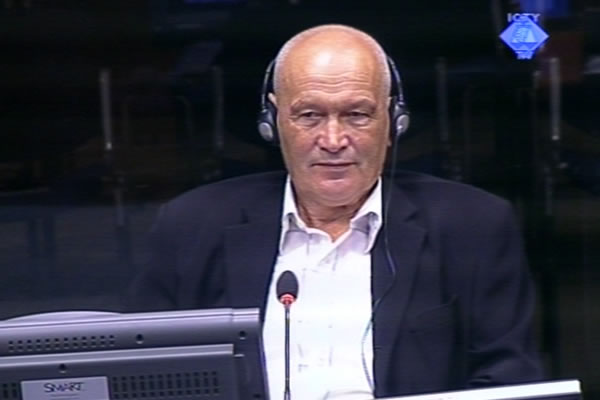Home
WITNESSES SURVIVED EXECUTIONS BY A MIRACLE
In a bid to prove that numerous crimes were committed against Bosnian Muslims in 1992 as part of the ethnic cleansing campaign in large parts of BH, the prosecution called two witnesses who managed to escape the execution sites after executions and live to see the end of the war
 Fejzija Hadzic, witness at the Ratko Mladic trial
Fejzija Hadzic, witness at the Ratko Mladic trial The trial of Ratko Mladic continued today with the evidence of two witnesses, who come from two different parts of BH. The two had been through almost identical experiences. In 1992, they were arrested, robbed, held captive for a while, tortured and then brought to an execution site. Both were lucky to escape. The prosecution wants to prove the systematic and widespread nature of the crimes listed in the indictment and the pattern of killing and expelling non-Serbs from areas the Bosnian Serb leadership claimed as theirs.
The first to appear this morning in court was Fejzija Hadzic. Before the war, Hadzic was a director of the municipal service company in Kalinovik. In late June 1992, Hadzic and dozens of Muslim civilians were arrested, robbed and detained in the local primary school. The witness was then transferred to a nearby gunpowder depot. Curiously enough, Mladic himself was born in the village of Bozinovici in Kalinovik municipality, where the crimes Hadzic described were committed.
As he answered questions asked by prosecutor Bibles, Hadzic said he was detained in the school in Kalinovik until 5 August 1992, when members of Pero Elez’s unit took Hadzic and 23 other prisoners out and drove them in military vehicles to a field near the village of Ratine in Foca municipality. The detainees were lined up and executed. The bodies were moved to a barn, doused in gasoline and set on fire. Before the fire engulfed the entire building, the witness was able to escape unnoticed. He had been shot in the leg and his hands were tied. After a while, the witness joined a column of other refugees in the nearby hills and he was given first aid.
Since then, the witness said, ‘I’ve lived with my trauma’. Hadzic has already testified at the trial of Momcilo Krajisnik in The Hague. In Sarajevo, Hadzic appeared as a witness at the trial of several members of the Bosnian Serb army and the police who took part in the crimes in Kalinovik municipality. The judges in the Krajisnik case accepted Fejzija Hadzic’s testimonyin its entirety, basing their findings about the events in Kalinovik on his statement and other evidence.
In the cross-examination, Miodrag Stojanovic, the defense lawyer of the former Bosnian Serb Army commander tried to shift the blame for the crimes in Kalinovik and Foca areas on the police. The witness confirmed that policemen took part in his arrest. However, Hadzic insisted that he was taken from the primary school to the gunpowder depot in a military vehicle. Soldiers wearing olive drab uniforms took the group of prisoners to the execution site and executed them there, Hadzic said. The defense counsel put it to the witness that the crime was committed because a number of Serb soldiers had been killed in combat in the area before the incident. This prompted the witness to say that ‘there can be no causal link between killing soldiers on the front line and murdering civilians’.
Another Bosnian Muslim was called after Hadzic completed his evidence. The protected witness testified with voice distortion and under the pseudonym RM 010. The court went into private session often during his testimony. The witness described how soldiers in olive drab uniforms arrested him in the summer of 1992 in Kljuc municipality. The witness and about 150 to 170 other Muslims were detained in the primary school in the village of Biljani. They were searched by police officers who robbed them. On 10 July 1992, the prisoners were beaten and put on buses. They were taken to a field and executed. The witness’s group was fired on by soldiers but the witness wasn’t hit. About an hour later, he was able to escape from the execution site and save his life by fleeing to the woods.
The indictment against Ratko Mladic alleges that after the witness escaped, 144 dead bodies were left lying in the field. As the witness said, this was not the only crime in which Muslims were murdered in Kljuc municipality. After the war, in the fall of 1996, bodies of hundreds of civilians were exhumed at three sites nearby. The witness was present when two of the mass graves were exhumed.
Prosecutor D’Ascoli completed the examination-in chief of the witness RM 010. General Ratko Mladic’s defense will cross-examine the witness tomorrow. Mladic is on trial for double genocide and other crimes in BH. The accused didn’t cause any problems today during the hearing, except for the fact that he didn’t come back into the courtroom after one of the breaks. Defense counsel Stojanovic told the judges that Mladic was ‘very upset, red in the face and his speech is agitated’. Mladic returned to the courtroom soon afterwards and the trial resumed.
Linked Reports
- Case : Mladic
- 2012-08-28 ‘ARSONISM’ IN SARAJEVO
- 2012-08-27 MLADIC WANTED TO ‘ROLL OUT THE MINDS’ OF THE PEOPLE IN SARAJEVO
- 2012-08-24 MLADIC APOLOGIZES
- 2012-08-30 EVIDENCE ON EXECUTION IN BILJANI COMPLETED
- 2012-08-31 MLADIC REMOVED FROM COURTROOM
- 2012-09-03 WITNESS OF MASSACRE IN ROOM 3 IN KERATERM PRISON CAMP
